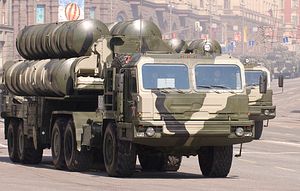India and Russia signed an inter-governmental agreement for the procurement of four (some sources say five) regiments of Russian-made S-400 Triumf advanced Air Defense Systems (NATO reporting name: SA-21 Growler) on October 15 in Goa, India at the sidelines of the eight BRICS summit. The deal, along with 17 other cooperation agreements, was signed in the presence of Indian Prime Minister Narendra Modi and Russian President Vladimir Putin.
“An intergovernmental agreement has been signed today, under which the Russian side has undertaken to deliver S-400 [to India],” the head of the Russian state-owned defense and technology conglomerate Rostec, Sergey Chemezov, told reporters, according to RT. Russia expects a $4.5 billion commercial contract to be signed by the middle of 2017. “We will then start preparing the contracts and I hope that in the first half of 2017 we will complete and sign these contracts and the production will start. I believe the delivery will begin somewhere in 2020,” Chemezov added.
India is only the second country after China, which ordered six S-400 units in 2014, to receive one of Russia’s most advanced air defense systems. “S-400 it is our newest system. We are currently equipping our own military forces with it and we are making an exception only for our closest allies, such as India and China, “ said Russia’s Deputy Prime Minister Dmitry Rogozin. “The fact that we have reached agreements with both India and China [regarding S-400 delivery] shows a lot. It shows that Russia exports its most advanced technologies to the countries it trusts, with which it is building strategic partnerships.”
The Indian Ministry of Defense’s Defense Acquisition Council (DAC) cleared the S-400 purchase in December 2015. The new weapon system, capable of engaging stand-off jammer aircraft, Airborne Warning and Control System (AWACS) aircraft, and both ballistic and cruise missiles in an electronic countermeasures environment—will be a significant boost to India’s so called anti-access/area denial (A2/AD) capabilities.
As I noted previously (See: “A2/AD Threat: Russian Army Adds 2nd S-400 Regiment in 2016”), one S-400 regiment is divided into two battalions. Each battalion consists of eight launchers and 32 missiles in addition to acquisition and engagement radar systems and a command post. Furthermore I explained:
In comparison to its predecessor, the S-300, the S-400 air defense system features an improved radar system and updated software; it can purportedly can fire four new types of surface-to-air (SAM) missiles in addition to the S-300’s 48N6E, a vertical tube launched, solid fuel, single stage SAM with an estimated range of 150 kilometers (93 miles), and the improved 48N6E2 missile with a reported range of 195 kilometers (121 miles).
One of the S-400’s new missiles is the so-called 40N6 SAM with an estimated operational range of 400 kilometers (248.5 miles) and an altitude of up to 185 kilometers (607,000 feet). The missile is reportedly capable of exo-atmospheric interception of intermediate-range ballistic missile warheads in their terminal phase. However, it is unclear whether the weapon is operational in Russia yet and no images of the 40N6 SAM have surfaced so far.
The S-400 is also armed with an improved variant of the 48N6E2 with an alleged range of 250 kilometers (160 miles). The air defense system can also fire two additional missiles, the 9M96E and 9M96E2 with respective ranges of 40 km (25 miles) and 120 km (75 miles). Improved S-300 air defense systems such as the S-300PMU-2 Favorite (sold to Iran), can purportedly also fire the 9M96E and 9M96E2. The S-400 can purportedly fire missiles at a rate 2.5 times faster than its predecessor, the S-300.
It is unclear what missiles Russia will supply to India. The India military is slated to deploy three S-400 regiments in the West facing Pakistan and two regiments in the country’s East near the Sino-Indian border. The introduction of the S-400 into South Asia will likely force Pakistan to step up its asymmetrical defense capabilities, given that the weapon system, even more so than the S-300 already in service with the Indian military, can deny the Pakistan Air Force access to its own airspace.
Last weekend, India and Russia also signed an agreement for the purchase four Admiral Grigorovich-class (Project 11356) guided-missile frigates frigates. The 3,620-ton Admiral Grigorovich-class is a variant of Talwar-class frigate, six of which Russia built for the Indian Navy between 2003 and 2013. Furthermore, both sides inked a deal for India to lease an inactive Akula-class multi-purpose nuclear submarine. Last, Rosoboronexport, Russian Helicopters, and India’s Hindustan Aeronautics Limited (HAL) agreed to create a joint venture for the production of Ka-226T helicopters.
































